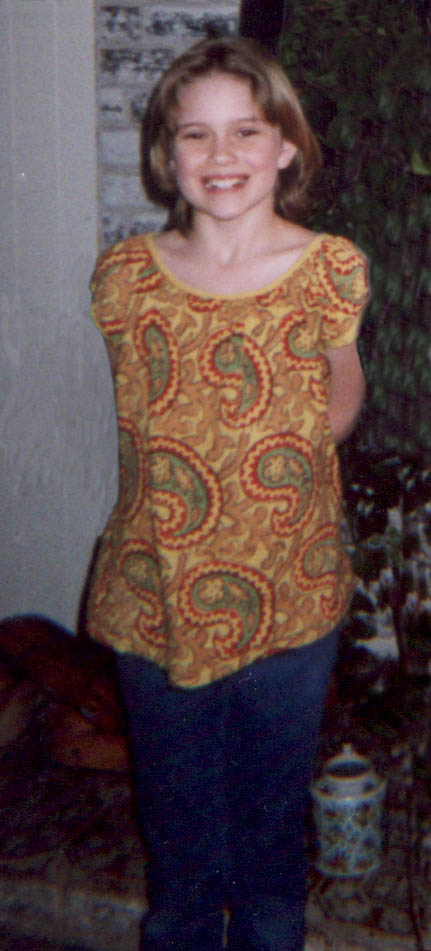Art, Aging and Spirituality
Connections between Things and Ideas
by Sandra Dodd, for Enchanted Families, Spring 2001The editor gave me a list of three topics, and a happy memory of 9th grade English came to me—some of us used to take the list of ten vocabulary words, the directions for which were "use each word in a sentence," and try to use them all in one sentence. Sometimes we'd need two or three sentences, but we considered those who wrote ten different sentences to be missing all the fun. Remembering that reminds me of how long I\'ve considered words some of the finest construction toys around. When I've taught people about the history of English, I've used the analogy that Anglo Saxon words are like blocks (put together but still separate, like upkeep and downtown and playlike and upside down), but words we have from French and Latin are tinkertoys with attachments which don't stand alone (interesting and fascinating combinations of exceedingly complicated construction). That was thirty years ago, in the late 60\'s and early 70's, that I was so newly interested in rolling in words.
In 1970 I lived in Hokona Zia dorm, at UNM. I was 17 whole years old, and had my mom\'s old 1952 Singer portable sewing machine. India-print bedspreads were $4 and $5 each at Gold Street Circus, a hippie shop that wasn't on Gold Street, but on Central across from Hodgin Hall. (Now it's the west end of Bike World.) Up Central at Wellesley, where a restaurant named Kelly's lately opened, there was a Goodwill. It had been a car dealership way before I was born. You could still tell by the building where the office, the repair shop, and the showroom had been. I bought two garments for a dollar apiece, and copied them many times. Between that and a little book called The Illustrated Hassle-Free Make Your Own Clothes Book, I grew brave about sewing without bought patterns.
Most of my India-print clothing was worn happily to rags. But one little yellow, brown and green flower-patterned shirt, based on one of the little tops from Goodwill, was in great shape and waiting in a box of old clothes for its unforeseen adventures.

I waited to have children, and my youngest is nine now. She came upon this hippie shirt and wanted to wear it. I have seen her on Central, and at the University, in that top which has been there before. As with every single other place and person, some things at UNM are the same, and some are very different.
Holly has become fascinated by musicals. When I was her age I knew nothing but Peter Pan, from TV. She can do some detailed comparison/contrast on Jesus Christ, Superstar and Godspell, and can sing Joseph and the Amazing Technicolor Dreamcoat through with feeling. All of those date to the time of that shirt, of my learning to sew, of my word-rolling, and of my philosophical blossoming.
I was studying education in the early 1970's, having wanted to be a teacher since first grade. The university was a hotbed of radical new thought about learning, spirituality, the value and valuing of the human life and spirit. I was in my late teens, and eager to take my turn at trying to change the world. We read all the then-current discussions of classroom failure—James Herndon, A.S.Neill, Jonathan Kozol and John Holt—and I lived and breathed in their hopeful vision of the future of free schools and open classrooms. I taught hard, and after six years I quit. I never did quit learning, though.
Newer John Holt books were waiting for me fifteen years later, when my firstborn son was expressing his distaste for organized activities and formal learning.
While I was making him little medieval costumes and taking him to feasts and tournaments where I set him down to play with his collection of could-have-been-medieval wooden and clay and metal toys, he being part and parcel of that ongoing work of performance art which is the Society for Creative Anachronism, I started to think that maybe school wasn't going to benefit a child who was resistant to group control and already surrounded by learning opportunities which my distant impersonal gurus of education would have approved. Homeschooling seemed part and parcel of the respect for individuals and the attachment parenting which had flowed so freely from my previous experiences.
We all are preparing for our unseen futures, and I was prepared to homeschool. I am prepared to discuss the social history of the 70's musicals Holly is frolicking with now, in a shirt I made when a brand new India print bedspread could be bought by a barefooted hippie for $4. She is surprisingly prepared, at the age of nine, to understand it.
Commentary on "Art, Aging and Spirituality"
(Wynn, an in-person friend who knows Holly,
and who homeschools in New York state)
Hi Sandra,
I love reading your thoughts on unschooling. I've been 'doing' it for 13+ years. Got eight kids. I too used to sew my own clothes from the hassle free book. That brought back such memories. I wore these in 8th grade and up. I loved that book.
My 11, 8, and 4 year olds are currently hot on the medieval trail. Is there a 'hassle free' book for historical/period clothing? Thanks for being there to inspire me.
Brigid

Holly Dodd
